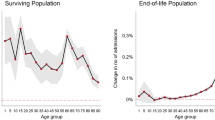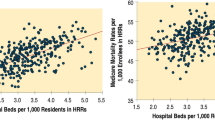Abstract
We examine the length of time between when an individual feels sick and when he/she visits a doctor using survival analysis to capture the dynamic aspects of this behavior. If the disease is light, actions such as OTC medicine or sick leave are alternatives to visiting a clinic or a hospital immediately. The timing of the visit depends only the person's decision, not on a doctor's, so we can limit discussion to the effect of ex-post moral hazard excluding physician induced demand. Participants were asked to keep a log of illness-related behavior such as dates of episodes, subjective symptoms, sick leaves, and medical treatment at hospitals. Neither the copayment rate nor access cost had a significant effect on the behavior of visiting a doctor, whereas available alternatives delay the timing of a visiting. Severe symptoms and fever hastened the time. The results suggest that the traditional argument about ex-post moral hazard is somewhat misleading.
Similar content being viewed by others
References
Newhouse JP (1993) Free for All? - Lessons from the Rand Health Insurance Experiment (Harvard University Press, Cambridge).
Pohlmeier W, Uhrich V (1995) “An econometric model of the two-part decision-making process in the demand of health care” Journal of Human Resources 30(2): 339–361.
Puig-Junoy J, Saez M, Martinez-Garcia E (1998) Why do patients prefer hospital emergency visits? A nested multinomial logit analysis for patient-initiated contacts Health Care Management Science 1: 39–52
Gertler P, Locay L, Sanderson W (1987) Are user fees regressive? The welfare implications of health care financing proposals in Peru. Journal of Econometrics 36: 67–88
Gilleskie D (1998) A dynamic stochastic model of medical care use and work absence. Econometrica 66(1): 1–45.
Bessho S, Ohkusa Y (2003) What determine hospital choice?: Time cost, option demand, and communication mimeoD.
Nagase K (1935) Accident and Sickness Statistics, (Kenko Hoken Ihosha, Tokyo) (in Japanese)
Ii M, Ohkusa Y (2002) Economic Analysis of Medical Care Service, (Nihon Keizai Shimbunsha, Tokyo). (in Japanese)
Evans WN, Levy H, Simon KI (2000) Research data in health economics. Journal of Economic Perspectives 14(4): 203–216
Zweifel P, Manning WG (2000) Moral hazard and consumer incentives in health care, Handbook of Health Economics. Volume 1A, A. J. Culyer and J. P. Newhouse (eds.), (Elsevier Science, Amsterdam)
Santos S, Joao MC, Windmeijer F (2001) Two-part multiple spell models for health care demand. Journal of Econometrics 104: 67–89
Deb P, Holmes AM (2000) Estimates of use and costs of behavioural health care: A comparison of standard and finite mixture models. Health Economics 9: 475–489
Nakahishi S (2000) Consumer behavior of medical care demand: Estimation of the dynamic demand function. Japanese Journal of Health Economics and Policy 7: 65–76. (in Japanese)
Sawano K (2000) Co-payment, coinsurance rate and the elderly care in Japan. Journal of Health Care and Society 10(2): 115–138. (in Japanese).
Ii M, Ohkusa Y (2002) Price sensitivity of the demand for medical services for minor ailments: econometric estimates using information on illnesses and symptoms Japanese Economic Review 53(2): 154–166
Ii M, Ohkusa Y (2002) Should the coinsurance rate be increased in the case of common cold? An analysis based on an original survey, Journal of the Japanese and International Economies 16: 1–19
Yoshida A, Takagi S (2002) Effects of the reform of the social medical insurance system in Japan. Japanese Economic Review 53(4): 444–465
Wooldridge JM (2002) Econometric Analysis of Cross Section and Panel Data (MIT Press, Cambridge)
Kiefer NM (1988) Economic duration data and hazard functions. Journal of Economic Literature 26(2): 646–679
Lancaster T 1990 The Econometric Analysis of Transition Data, (Cambridge University Press, Cambridge).
Hosmer DW, Lemeshow S (1999) Applied Survival Analysis: Regression Modeling of Time to Event Data, (John Wiley & Sons).
Gilleskie DB, Mroz TA (2000) Estimating the effects of covariates on health expenditures. NBER Working Paper Series 7942.
Acton JP (1975) Nonmonetary factors in the demand for medical services: Some empirical evidence, Journal of Political Economy 83(3): 595–614
Grossman M (1972) On the concept of health capital and the demand for health. Journal of Political Economy 80(2): 223–255
Smith JP (1999) Healthy bodies and thick wallets: The dual relation between health and economic status. Journal of Economic Perspectives 13(2): 145–166
Author information
Authors and Affiliations
Corresponding author
Additional information
The data used had been collected by Yasushi Ohkusa, financed by the Japanese Ministry of Education and Science (2000 Scientific Research Grant, titled “Evaluation for Economic Institution Based on Empirical Research for Household Behavior” (grant number:12124207), headed by Fumio Hayashi of the University of Tokyo. We gratefully acknowledge the comments by two anonymous referees, Toshihiro Ihori, Masayo Sato, Masayoshi Hayashi, Kiyoshi Mitsui, Masako Ii, Hiromi Hara, Yusuke Ono, Ryoko Morozumi and seminar participants at ISER Osaka University and Yokohama National University. The usual disclaimer applies.
Rights and permissions
About this article
Cite this article
Bessho, Si., Ohkusa, Y. When do people visit a doctor?. Health Care Manage Sci 9, 5–18 (2006). https://doi.org/10.1007/s10729-006-6276-8
Received:
Accepted:
Issue Date:
DOI: https://doi.org/10.1007/s10729-006-6276-8




